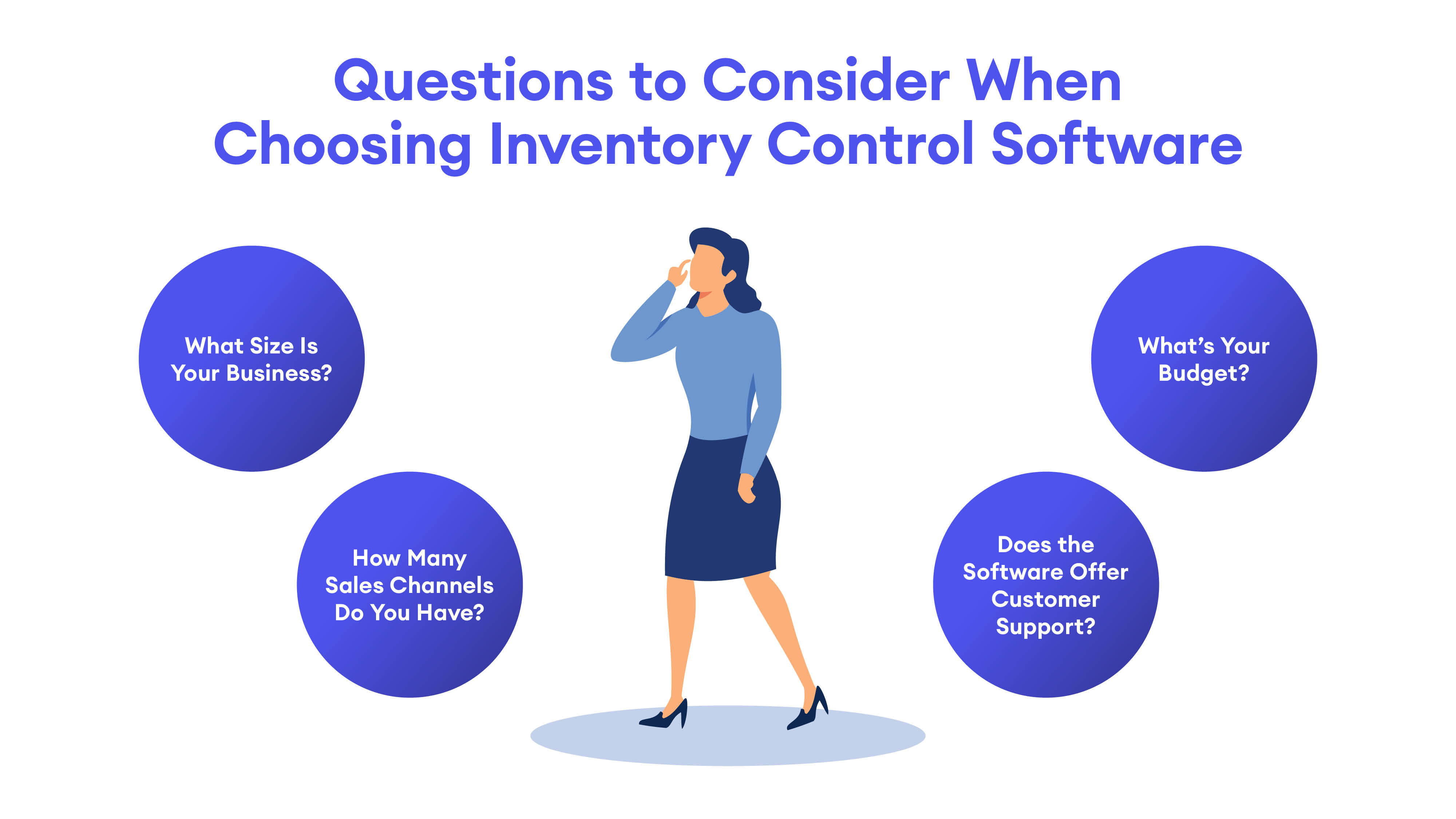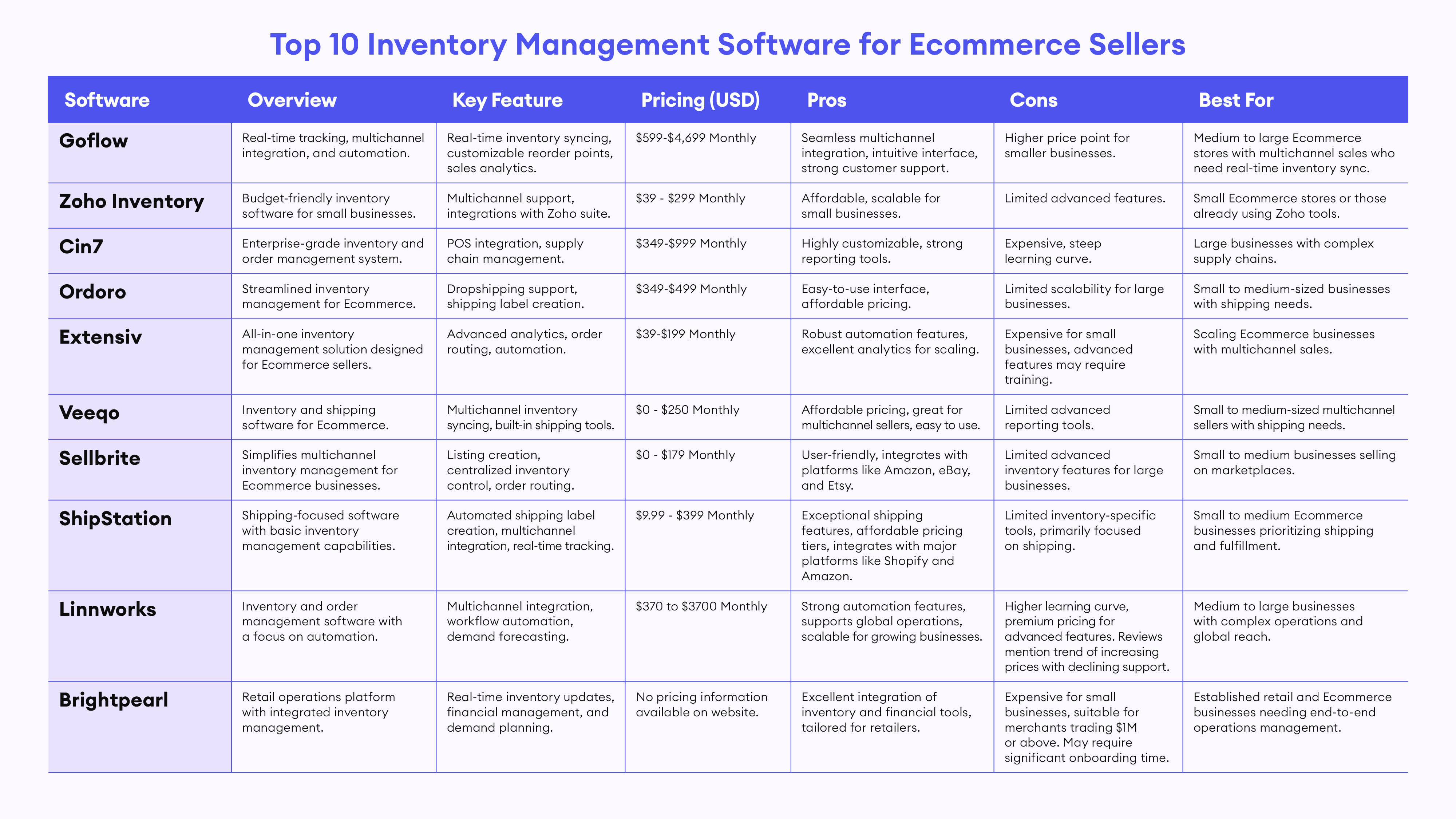Which Inventory Management Software Should I Use for My Ecommerce Store?

According to recent research, 58% of retailers have less than 80% inventory accuracy.¹
Those aren’t exactly stellar results! We can do a lot better than that when it comes to having a clear picture of what’s in stock, and it starts with choosing the right inventory management software.
Inventory management software solves common ecommerce challenges like stockouts, overstocking and inefficiencies. It ensures you always have the right inventory levels, and it improves efficiency by automating tasks such as reordering and order fulfillment. You’ll be able to grow your business easily as you add new products and sales channels, while keeping your inventory managed from one easy-to-use dashboard.
Choosing the right inventory management software can be a challenge, due to the overwhelming number of options available. They’re all different, and one might be a better fit for your business depending on your needs.
In this post, we’ll provide you with an unbiased, comprehensive comparison of the pros and cons of top software options, to help you find the best fit for your business needs.
Key Features to Look For in Inventory Management Software
Depending on the needs of your particular business, you may be looking for different features when it comes to choosing inventory management software. However, most businesses will be looking for certain core features.
A robust inventory management system automatically updates inventory in real time by handling all related activities within a fully integrated, scalable platform that supports syncing, multi-warehouse operations, detailed location tracking, and a customizable API.
Here are some of the most important features you’ll want to have on your list as you conduct an ecommerce inventory software comparison:
Automated Inventory Updates: All inventory-related transactions—purchasing, receiving, billing, transfers, assemblies, and more—are automatically recorded in real time.
Integrated Operations: All activities impacting inventory are handled within a single platform, eliminating silos and manual processes.
Real-Time Syncing Across Channels: Inventory availability is updated instantly across all sales channels and systems as transactions occur. This avoids overselling and underselling on multichannel platforms, as your inventory will become available on all channels immediately upon receipt or availability.
Support for Multiple Warehouses: Manages inventory across multiple locations, including 3PLs, FBA, and vendor-managed stock.
Detailed Location Tracking: Tracks inventory down to specific locations within each warehouse for precise organization.
Scalability for Growth: Handles increasing complexity and scale as your business grows, avoiding future limitations.
Customizable, Reliable API: Provides a robust API with detailed documentation for seamless integrations and customized workflows.
Ecosystem Integration: Integrates with sales channels, partners, and warehouse systems, aligning inventory with order fulfillment.
 What Size Is Your Business?
What Size Is Your Business?
It’s important to consider the size of your business when you’re choosing inventory management software, as this will influence the software you choose. For example, if you’re a small business such as a handmade jeweller on Etsy, you’ll likely be looking for software that is affordable and easy to use.
If you’re a medium-sized business, you’ll want to look for software that has a balance between features and scalability. For a large business, such as a multinational clothing brand, you’ll need something that is very robust and customizable.
Plus, it’s important to ask yourself whether the option you choose is scalable. If your business is likely to rapidly boom in the near future, can the software grow with you?
How Many Sales Channels Do You Have?
Another question to ask yourself is whether you’re selling on a single channel, or whether you’re building a multichannel ecommerce business.
Multichannel sellers need a single source of inventory truth, outside of any given channel. After all, Amazon or Shopify have great inventory management features, but they cannot support other channels. So, if you sell across multiple channels you’ll be looking for tools that offer seamless integration across platforms.
What’s Your Budget?
Each software option will have a different price point, so it’s up to you to determine a budget that your business can sustain. Ideally, the increased profit and productivity more than covers the investment for the inventory management software. But of course, this is something you’ll need to calculate yourself for your business.
Does the Software Offer Customer Support?
Getting started with inventory management software can be a steep learning curve, and you may need help getting set up and learning how to use the software. Look into how responsive the customer support team is and what onboarding support they offer. Plus, you can always check the reviews to find out what it was really like. Does the software get great reviews for support, or were users left in the dark to figure it out on their own?
Top Inventory Management Software 2025: 10 Options for Ecommerce Sellers

Let’s take a look at 10 top options for stock tracking software for ecommerce, assessing their key features, pros, cons, pricing ranges and best use cases. (Pricing information is accurate as of January 2025.)
Software | Overview | Key Features | Pricing (USD) | Pros | Cons | Best For |
Goflow | Real-time tracking, multichannel integration, and automation. | Real-time inventory syncing, customizable reorder points, sales analytics. | $599-$4,699 Monthly | Seamless multichannel integration, intuitive interface, strong customer support. | Higher price point for smaller businesses. | Medium to large Ecommerce stores with multichannel sales who need real-time inventory sync. |
Zoho Inventory | Budget-friendly inventory software for small businesses. | Multichannel support, integrations with Zoho suite. | $39 - $299 Monthly | Affordable, scalable for small businesses. | Limited advanced features. | Small Ecommerce stores or those already using Zoho tools. |
Cin7 | Enterprise-grade inventory and order management system. | POS integration, supply chain management. | $349-$999 Monthly | Highly customizable, strong reporting tools. | Expensive, steep learning curve. | Large businesses with complex supply chains. |
Ordoro | Streamlined inventory management for Ecommerce. | Dropshipping support, shipping label creation. | $349-$499 Monthly | Easy-to-use interface, affordable pricing. | Limited scalability for large businesses. | Small to medium-sized businesses with shipping needs. |
Extensiv | All-in-one inventory management solution designed for Ecommerce sellers. | Advanced analytics, order routing, automation. | $39-$199 Monthly | Robust automation features, excellent analytics for scaling. | Expensive for small businesses, advanced features may require training. | Scaling Ecommerce businesses with multichannel sales. |
Veeqo | Inventory and shipping software for Ecommerce. | Multichannel inventory syncing, built-in shipping tools. | $0 - $250 Monthly | Affordable pricing, great for multichannel sellers, easy to use. | Limited advanced reporting tools. | Small to medium-sized multichannel sellers with shipping needs. |
Sellbrite | Simplifies multichannel inventory management for Ecommerce businesses. | Listing creation, centralized inventory control, order routing. | $0 - $179 Monthly | User-friendly, integrates with platforms like Amazon, eBay, and Etsy. | Limited advanced inventory features for large businesses. | Small to medium businesses selling on marketplaces. |
ShipStation | Shipping-focused software with basic inventory management capabilities. | Automated shipping label creation, multichannel integration, real-time tracking. | $9.99 - $399 Monthly | Exceptional shipping features, affordable pricing tiers, integrates with major platforms like Shopify and Amazon. | Limited inventory-specific tools, primarily focused on shipping. | Small to medium Ecommerce businesses prioritizing shipping and fulfillment. |
Linnworks | Inventory and order management software with a focus on automation. | Multichannel integration, workflow automation, demand forecasting. | $370 to $3700 Monthly | Strong automation features, supports global operations, scalable for growing businesses. | Higher learning curve, premium pricing for advanced features. Reviews mention trend of increasing prices with declining support. | Medium to large businesses with complex operations and global reach. |
Brightpearl | Retail operations platform with integrated inventory management. | Real-time inventory updates, financial management, and demand planning. | No pricing information available on website. | Excellent integration of inventory and financial tools, tailored for retailers. | Expensive for small businesses, suitable for merchants trading $1M or above. May require significant onboarding time. | Established retail and Ecommerce businesses needing end-to-end operations management. |
Inventory Management Tools for Online Stores: Which Is Best for You?
Choosing the right inventory management software is a crucial decision that can streamline your operations and have a profound impact on the success of your ecommerce business.
It’s worth taking the time to research these options thoroughly. Although it may take some time to find the right tool for you, it’s an investment that will pay off in efficiency and profitability.
For many ecommerce businesses, Goflow stands out as a robust, feature-rich option. Want to find out if it’s the right fit for you? Contact us today!
Start today by scheduling a demo!
¹ Global State of the Industry: Inventory Data Accuracy & Promising: https://fluentcommerce.com/wp-content/uploads/Global-State-of-the-Industry-Inventory-Data-Accuracy-Promising.pdf
